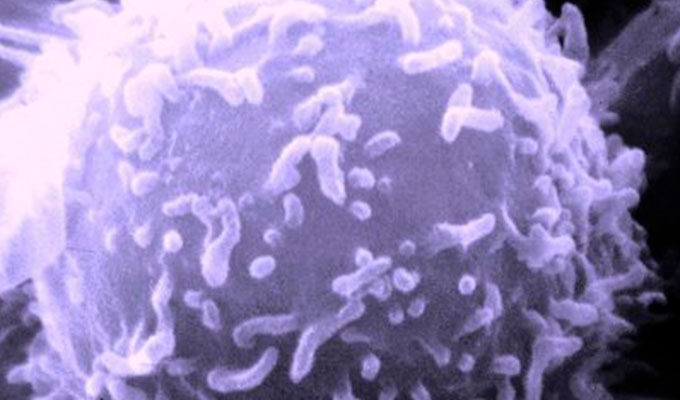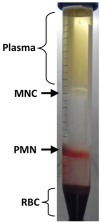
High quality isolation of lymphocytes is a key step in many in vitro research programs covering immunology, infectious diseases and oncology. To simplify this step, CEDARLANE® have developed an efficient and easy-to -use cell separation media: Lympholyte®

Lymphocytes (B, T and NK cells) belong to the family of White Blood Cells (WBC or leukocytes) together with monocytes and granulocytes. Found in the blood, bone marrow (where they are produced) and lymphoid tissues, Lymphocytes play a central role in the immune system and their blood rate might be affected during infections, genetic diseases, cancers...
Based on density gradiant centrifugation, Lympholyte® media allows isolation of viable Lymphocytes from mouse, rat, rabbit, human and other mammalian cell populations. Based on an easy cell separation procedure (Fig.1), Lympholyte® can be used for many applications:
- Isolation of viable lymphocytes from lymphoid organs by removal of red and dead cells
- Removal of dead cells and debris :
- From lymphocyte suspensions after treatment with antibody plus complement or following cell culture
- Following sequential cytotoxicity studies, eg. B-cell depletion
- From various clonal and hybridoma cell lines
- Removal of erythrocyte, dead cells and debris from various clonal and hybridoma cell line (Lympholyte®-M and-R)
- Isolation of mononuclear epidermal cells (Lympholyte®-M)
- Isolation of mononuclear cells from bone marrow preparations (Lympholyte®-H)

The resulting cell population demonstrates high, non-selective recovery of viable lymphocytes that are suitable for use as target cells in cytotoxicity, FACS assays and in vivo / in vitro functional studies. All Lympholyte products are supplied as a sterile liquid with varying densities.
Browse the overview of all the different Lympholyte® media available:
Lympholyte®-M (Mouse)
Lympholyte®-M is a density separation medium specifically designed for the isolation of viable lymphocytes from murine lymphoid cell suspensions. It can be used to eliminate erythrocytes, dead cells and debris from murine spleen, lymph node, thymus and bone marrow suspensions.
- Garaycoechea JI, Crossan GP, Langevin F, et al. (2012) Genotoxic consequences of endogenous aldehydes on mouse haematopoietic stem cell function. Nature. 489(7417):571-5.
- Pulido J, Kottke T, Thompson J, et al. (2012) Using virally expressed melanoma cDNA libraries to identify tumor-associated antigens that cure melanoma. Nat Biotechnol. 18;30(4):337-43.
- Y, Marumoto T, Friedmann-Morvinski D, et al. (2011) Transdifferentiation of glioblastoma cells into vascular endothelial cells. PNAS. 108(11):4274-80.
Lympholyte®-Rat
Lympholyte-Rat is ideal for the isolation of viable lymphocytes from rat lymphoid cell
suspensions. Its simple protocol enables the elimination of erythrocytes,
dead cells and debris from rat spleen, lymph node, thymus and bone marrow
suspensions.
- Bhalli JA, Shaddock JG, Pearce MG, et al. (2011) Report on stage III Pig-a mutation assays using benzo[a]pyrene. Environ Mol Mutagen. 52(9):731-7.
- Zhang ZX, Ma Y, Wang H, et al. (2006) Double-negative T cells, activated by xenoantigen, lyse autologous B and T cells using a perforin/granzyme-dependent, Fas-Fas ligand-independent pathway. J Immunol. 177(10):6920-9.
Lympholyte®-H (Human)

Lympholyte-H is designed for the isolation of viable lymphocytes and monocytes from
human peripheral and cord blood. Used for the elimination of erythrocytes and
dead cells from human blood, it can also removes the majority of granulocytes
(including neutrophils). The resulting cell population consists of a high and
non-selective recovery of viable human lymphocytes and monocytes.
- Spinelli E, Caporale R, Buchi F, Masala E, et al. (2012) Distinct Signal Transduction Abnormalities and Erythropoietin Response in Bone Marrow Hematopoietic Cell Subpopulations of Myelodysplastic Syndrome Patients. Clin Cancer Res. 18(11):3079-89.
- Colasanti T, Alessandri C, Capozzi A, et al. (2012) Autoantibodies specific to a peptide of β2-glycoprotein I cross-react with TLR4 inducing a pro-inflammatory phenotype in endothelial cells and monocytes. Blood. 120(16):3360-70.
- Pievani A, Belussi C, Klein C, Rambaldi A, Golay J, Introna M. (2011) Enhanced killing of human B-cell lymphoma targets by combined use of cytokine-induced killer cell (CIK) cultures and anti-CD20 antibodies. Blood. 117(2):510-8.
Lympholyte®-Rabbit
Rabbit lymphoid cells suspensions can be cleaned with Lympholyte-Rabbit, thus eliminating erythrocytes, dead cells and debris from rabbit
spleen, lymph node and thymus suspensions.
- Cameron CM, Barrett JW, Liu L, et al. (2005) Myxoma virus M141R expresses a viral CD200 (vOX-2) that is responsible for down-regulation of macrophage and T-cell activation in vivo. J Virol. 79(10):6052-67.
Lympholyte®-Mammal
Lympholyte-Mammal is a density separation medium specifically designed for the isolation of viable lymphocytes and monocytes from the peripheral blood of most mammalian species. It consists of Sodium Diatrizoate combined with Dextran to induce erythrocyte aggregation and reduce platelet aggregation resulting in a higher yield of lymphocytes and monocytes. Lympholyte-Mammal can be used for the elimination of erythrocytes and dead cells from the blood of most mammalian species. Lympholyte-Mammal also removes the majority of granulocytes (including neutrophils).
- Hoggatt J, Mohammad KS, Singh P, Hoggatt AF, et al. (2013) Differential stem- and progenitor-cell trafficking by prostaglandin E2. Nature. 495(7441):365-9.
- Lin WH, Kouyos RD, Adams RJ, Grenfell BT, Griffin DE. (2012) Prolonged persistence of measles virus RNA is characteristic of primary infection dynamics. PNAS. 109(37):14989-94.
Lympholyte®-Poly (Human)
Lympholyte-poly is a ready-made sterile and endotoxin tested solution which is a
mixture of sodium metrizoate and Dextran 500 that allows for the isolation of
human polymorphonuclear granulocytes from whole blood. Lympholyte-poly is
ideally suited for isolation of polymorphonuclear granulocytes (neutrophils,
eosinophils) from human whole blood. Mononuclear and polymorphonuclear
leukocytes are separated into two distinct bands free from erythrocytes. It has
also been found to be suitable for the isolation of neutrophils from bronchial
lung lavage suspension.
- Swystun LL, Mukherjee S, Liaw PC. (2011) Breast cancer chemotherapy induces the release of cell-free DNA, a novel procoagulant stimulus. J Thromb Haemost. 9(11):2313-21.
- Marquez-Curtis L, Jalili A, Deiteren K, et al. (2008) Carboxypeptidase M expressed by human bone marrow cells cleaves the C-terminal lysine of stromal cell-derived factor-1alpha: another player in hematopoietic stem/progenitor cell mobilization? Stem Cells. 26(5):1211-20.
Lympholyte®-1.1
Lympholyte-1.1 is specifically designed for the isolation of islet cells from the
pancreas. Lympholyte-1.1 can be used undiluted to eliminate non-islet tissue
such as exocrine fragments, lymph nodes, ganglia, ductal and vascular tissue
from pancreatic cell suspension. The resulting cell population consists mainly
of islet cells that may be expanded for use in vivo.
- Arafat HA, Katakam AK, Chipitsyna G, et al. (2007) Osteopontin protects the islets and beta-cells from interleukin-1 beta-mediated cytotoxicity through negative feedback regulation of nitric oxide. Endocrinology. 148(2):575-84.
What is your preferred solution to simplify lymphocytes isolation?
Contact your tebu-bio local office and find the Lympholyte solution the most suitable to your experiments.
Interested in Lympholytes? Browse our full offer of complementary products:

